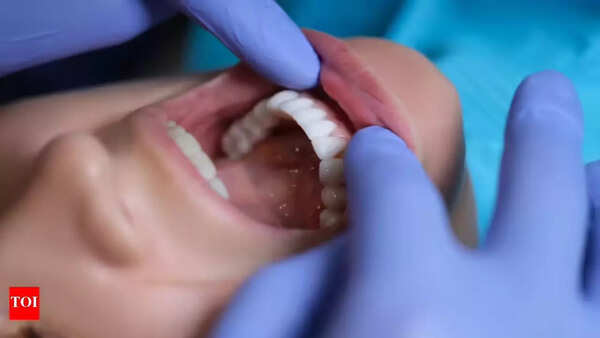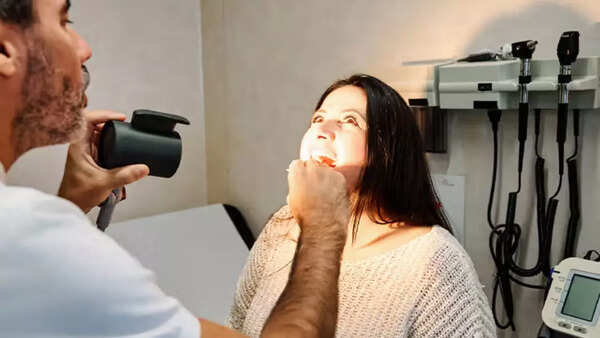Oral cancer, also known as mouth cancer, is a serious condition that develops in the tissues of the oral cavity. This includes the lips, tongue, gums, inner cheeks, and the roof or floor of the mouth. In some instances, it can affect the oropharynx, the area at the back of the throat.
Often beginning as a painless sore or patch, oral cancer can easily go unnoticed in its early stages. Regular dental checkups and self-examinations are crucial for early diagnosis. While anyone can be affected, certain lifestyle factors like tobacco and alcohol use significantly increase the risk. Early detection and prompt treatment are vital for improving outcomes and survival rates.
Oral cancer is a type of head and neck cancer that originates in the tissues of the mouth. This encompasses areas such as the lips, tongue, cheeks, gums, the floor and roof of the mouth, and sometimes the oropharynx. It typically manifests as a persistent sore, patch, or lump that doesn't heal, often mistaken for a less serious ailment in its initial phases.
Untreated oral cancer can spread to nearby structures, including lymph nodes and other parts of the head and neck. In advanced cases, it can even reach distant organs. Despite its potential severity, oral cancer is highly treatable when diagnosed early.
While oral cancer predominantly affects individuals aged 60 and older, it can also occur in younger people. Men are statistically twice as likely to develop it compared to women. Among different racial groups, white men exhibit a higher incidence rate than Black men. Approximately 11 in 100,000 individuals will be diagnosed with oral cancer during their lifetime.
This type of cancer is particularly concerning due to its subtle and often painless early symptoms, leading to delays in diagnosis and treatment.
Oral cancer often presents as persistent changes in the mouth that do not resolve. These can include:
Visible Signs:
Sensory and Functional Symptoms:
While these symptoms can resemble other conditions like infections or ulcers, their persistence should prompt concern and medical evaluation.

Image: Illustration depicting common symptoms of oral cancer.
Performing a monthly self-exam can aid in identifying unusual changes early:
If you find anything unusual, consult a healthcare professional immediately.
Oral cancer can significantly impair a person's ability to speak, chew, swallow, and even breathe, depending on the tumor's location and size. When it affects the oropharynx, it can lead to oropharyngeal cancer, impacting the base of the tongue, soft palate, tonsils, and the back of the throat.
The oral cavity, where oral cancer typically begins, includes:

Image: A dentist performing an oral cancer screening exam.
Oral cancer originates in squamous cells, the thin, flat cells lining the inside of the mouth. Mutations in these cells, often caused by prolonged exposure to carcinogens, lead to uncontrolled multiplication and tumor formation.
Major Risk Factors:
According to Healthline reports, approximately 25% of oral cancer cases occur in individuals without any of the above risk factors, emphasizing the importance of regular oral screenings.

Image: Illustration of the oral cavity highlighting areas affected by oral cancer.
Diagnosis typically begins during routine dental or medical exams. Dentists often play a crucial role in early detection. Diagnostic methods include:
Once a lesion is confirmed as cancerous, additional tests are performed to determine the stage, which influences treatment options.
Oral cancer is staged using the TNM system:
Staging helps doctors determine the most effective treatment and estimate the patient's prognosis.
While not all cases can be prevented, the risk can be significantly reduced through:
Life after oral cancer treatment varies. Some patients experience minor changes, while others face long-term impacts on speaking, chewing, and appearance. Support from reconstructive surgery, physical therapy, speech therapy, and mental health counseling may be needed. Ongoing check-ups are essential, as recurrence or secondary cancers are possible.
Newer articles
Older articles
 Rishabh Pant's Fearless Batting Revolutionizing Test Cricket, Says Greg Chappell
Rishabh Pant's Fearless Batting Revolutionizing Test Cricket, Says Greg Chappell
 Gavaskar Calls for Kuldeep Yadav's Inclusion Amid Bumrah Fitness Concerns Ahead of Second England Test
Gavaskar Calls for Kuldeep Yadav's Inclusion Amid Bumrah Fitness Concerns Ahead of Second England Test
 Mirabai Chanu: Weightlifting Star's Relentless Focus Extends Beyond the Gym
Mirabai Chanu: Weightlifting Star's Relentless Focus Extends Beyond the Gym
 Former Selector Blasts India's Fielding Woes After Test Defeat to England
Former Selector Blasts India's Fielding Woes After Test Defeat to England
 Is Facial Icing Right for You? Exploring Benefits, Risks, and Safe Practices of the Viral Beauty Trend
Is Facial Icing Right for You? Exploring Benefits, Risks, and Safe Practices of the Viral Beauty Trend
 Sharma Details 'Heart-in-Mouth' Moment as Yadav's Gravity-Defying Catch Fuels India's T20 World Cup Run
Sharma Details 'Heart-in-Mouth' Moment as Yadav's Gravity-Defying Catch Fuels India's T20 World Cup Run
 Hair Oil vs. Hair Serum: Which Treatment is Best for Your Hair Type? A Complete Guide
Hair Oil vs. Hair Serum: Which Treatment is Best for Your Hair Type? A Complete Guide
 Nitish Rana Eyes Delhi Return After Disappointing Uttar Pradesh Stint
Nitish Rana Eyes Delhi Return After Disappointing Uttar Pradesh Stint
 Prithvi Shaw Admits to Missteps, Vows Cricket Comeback After Career Setbacks
Prithvi Shaw Admits to Missteps, Vows Cricket Comeback After Career Setbacks
 ICC Test Rankings: Pant Soars to Career Best, Bumrah Still Reigns, Root Holds Top Batting Spot
ICC Test Rankings: Pant Soars to Career Best, Bumrah Still Reigns, Root Holds Top Batting Spot